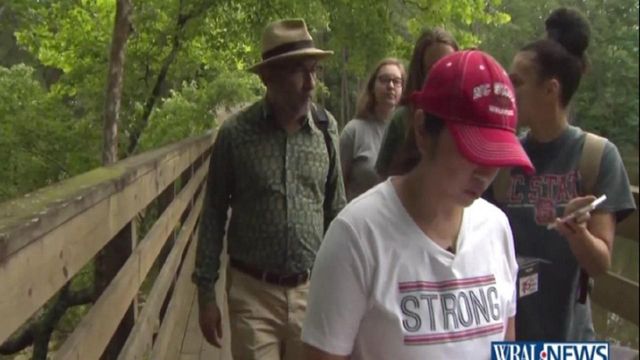In Florence's wake, NC State students seek lessons learned as part of hurricane study
Several students at North Carolina State University are participating in a study about Hurricane Florence and its aftermath.
Posted — Updated"This one's from Florence," said Miranda Smith, pointing across the trail to a fallen tree.
The tree is evidence of a storm long since passed. It was knocked down during Hurricane Florence.
"Well, you really think a hurricane impacts you once, but I know people who are still not in their houses from this hurricane," Smith said.
The students all lived through the storm and come from towns that suffered major damage. They are now part of a group of 50 NC State University students participating in a study of the storm and its aftermath .
The students are working in teams equipped with 360 degree cameras allowing them photograph all the damage they see. They are spread out over eastern North Carolina from the coast to Lumberton.
"I can't even imagine what it looked like during the hurricane," said Kristine Banet.
Rising sophomore Samantha Godfrey is from Sanford. Her family lost their home when Hurricane Matthew flooded the area while she was in high school.
"When I heard about the research being done for other hurricanes I thought I could contribute," she said.
Godfrey said she struggled in school immediately following Matthew and couldn't believe another storm was headed right for the area a year later. She knows North Carolina is often in the path of large storms and hopes what she is doing will prove useful.
"If this research does go on to help other people who have had effects from hurricanes like I have it's worth it completely," she said.
The students are visiting some areas that haven't been seen or touched by humans since Florence came through. A boat launch near the Deep River in Chatham County provides a perfect example. The bank is still coated with about a foot of dried and hardened mud and you can see traces of mud high on the leaves on the trees showing where the water rested during the storm.
"Basically, like wherever you can see the mud up on the trees, it goes up eight to 10 feet, that's how high the water was," Godfrey said.
The students work with park rangers and local authorities to confirm what they are looking at is from Florence.
Researchers plan to eventually share this data with local communities, providing valuable information for dealing with future storms.
"We can do long-term monitoring of these sites and be able to document how these sites change over time," said Katti.
The study was made possible by a $200,000 grant from the National Science Foundation. NC State originally planned this research for winter break but the project was delayed because of the government shutdown in December and January.
The results of the study will be shared with the public as part of a multi-media presentation at NC State's library this fall.
Related Topics
• Credits
Copyright 2024 by Capitol Broadcasting Company. All rights reserved. This material may not be published, broadcast, rewritten or redistributed.






